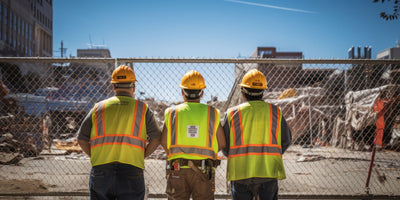Safety is the cornerstone of every successful construction project, and adherence to regulatory guidelines is paramount to ensure the well-being of workers and visitors alike. Among the myriad regulations governing construction safety, guidelines set forth by the Occupational Safety and Health Administration (OSHA) stand as a comprehensive framework for promoting safety on construction sites. In this blog, we'll take a deep dive into OSHA guidelines for construction site safety signage, unraveling the complexities and providing insights into compliance and best practices.
Understanding OSHA's Role in Construction Safety
The Occupational Safety and Health Administration (OSHA) is a federal agency tasked with ensuring safe and healthy working conditions for American workers. OSHA establishes and enforces standards to protect workers from occupational hazards, including those present on construction sites. Compliance with OSHA standards is mandatory for construction companies, and failure to adhere to these regulations can result in fines, penalties, and legal liabilities.
Construction Site Safety Signage: A Vital Component of OSHA Compliance
Safety signage plays a crucial role in communicating hazards, instructions, and precautions on construction sites. OSHA mandates the use of specific safety signage to alert workers and visitors to potential dangers and ensure compliance with safety protocols. Understanding OSHA guidelines for construction site safety signage is essential for promoting safety and avoiding regulatory violations.
Key OSHA Guidelines for Construction Site Safety Signage
-
Identification and Classification of Hazards: OSHA requires construction companies to conduct hazard assessments to identify and classify potential hazards present on construction sites. Based on the results of these assessments, appropriate safety signage must be installed to alert workers and visitors to hazards such as falling objects, electrical hazards, and confined spaces.
-
Types and Specifications of Safety Signage: OSHA specifies the types and specifications of safety signage to be used on construction sites. This includes color-coded signs for different types of hazards (e.g., red for fire hazards, yellow for cautionary hazards) and standardized symbols and text to convey safety messages effectively.
-
Placement and Visibility of Safety Signage: OSHA guidelines dictate the placement and visibility of safety signage to ensure maximum effectiveness. Signs must be placed in prominent locations where they are easily visible to workers and visitors, and they must remain unobstructed at all times. Additionally, signage must be reflective or illuminated for visibility in low-light conditions.
-
Training and Education on Safety Signage: OSHA requires construction companies to provide training and education to workers on the meanings and importance of safety signage. Workers must be able to recognize and understand the significance of different types of safety signs to effectively navigate construction sites and respond to hazards.
Best Practices for Compliance with OSHA Guidelines
-
Conduct Regular Safety Inspections: Regularly inspect construction sites to ensure compliance with OSHA guidelines for safety signage and address any deficiencies promptly.
-
Provide Comprehensive Training: Train workers on the meanings and importance of safety signage, as well as procedures for responding to emergencies and hazards identified by signage.
-
Utilize Clear and Visible Signage: Use clear and visible signage with standardized symbols and text to convey safety messages effectively to workers and visitors.
-
Stay Updated on Regulatory Changes: Stay informed about updates to OSHA regulations and guidelines for construction site safety signage to ensure ongoing compliance.
Conclusion: Prioritizing Safety Through OSHA Guidelines
In conclusion, navigating the tapestry of safety on construction sites requires a thorough understanding of OSHA guidelines for construction site safety signage. By adhering to these guidelines, construction companies can promote a culture of safety, protect the well-being of workers and visitors, and avoid regulatory violations. Safety signage is not just a legal requirement—it's a vital component of a comprehensive safety program that ensures the success and sustainability of construction projects.






